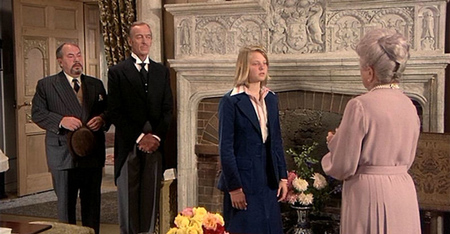Fond though I may be of Freaky Friday, when you get down into the soul of my live action Disney love, this is always going to be ahead for me. I tend to prefer the more obscure, as we’ll get into again when we start discussing Hayley Mills. The Disney Channel actually played Freaky Friday more often, as I recall, but my sisters and I would go out of our way to watch this one when we could. It’s one of the first movies I bought on DVD, and it may be one of the first Amazon purchases I ever made.
Jodie Foster is Casey Brown, an LA street kid growing up delinquent in the system. One day, she’s basically sold to a man named Harry Bundage (Leo McKern). She bears a resemblance to the long-lost Honourable Margaret, 4th Marchioness of St. Edmund. The girl was abducted by her father following a nasty divorce a decade earlier. The father is dead, killed in a car accident. The girl has never been found. Harry believes he can bring Casey in as the missing Margaret and use her to find the hidden treasure of pirate—really probably privateer—captain Joshua St. Edmund. His cousin, Grimsworthy (Vivian Pickles), had been a domestic at the family estate of Candleshoe and found what she believed to be the first clue that would lead them to the treasure.
Using a combination of Harry and Grimsworthy’s tutelage and her own cleverness, Casey convinces Lady St. Edmund (Helen Hayes in her final film role), the lost girl’s grandmother, that she is the real Margaret. She settles in to find the treasure. Casey knows little about upper class British poverty, but that’s what Lady St. Edmund lives in. Most of the house’s treasures have been sold off to pay land taxes. The only servant is the butler, Priory (David Niven). What’s more, Lady St. Edmund, in her loneliness—her daughter has also died—has taken in a cluster of children from the local orphanage. It’s clear that Lady St. Edmund is close to losing the house altogether.
What follows is basically a war for Casey’s inherent nature. She’s a good person who has learned to think of herself first and often always, because she’s been shuffled from one foster home to another in care of caregivers who only really want her for the check. She’s willing to go along with Harry’s plan because he’s going to cut her in for a percentage. However, she genuinely likes Lady St. Edmund, Priory, and the children, and she doesn’t much like the possible future they have ahead of them if they lose Candleshoe.
The question that is never fully answered is whether or not Casey is really Margaret. It’s made very clear that she might be. She’s the right age. She’s got the right scar and birthmark. She has no memory of England or her life before foster care, but given she would have been four at the time, and might have sustained a head injury in the crash if she was in the crash, there’s no reason to expect her to remember. Her food tastes have changed, but it’s been ten years spent in the US. The allergy, I don’t know about. But any way you look at it, it’s a possibility. These days, it would be very simple to run a DNA test, but did they even know young Margaret’s blood type?
This isn’t quite a classic heist movie, given that most of the plot involves patient solving of clues and developing of human emotions. It does, on the other hand, have an exciting and entertaining climax that involves the intelligence of pretty much the entire major cast. At least the good guys. And a train chase, and who can beat a train chase? I’ve convinced several people to see the movie based on that sequence alone.
The fact is, this is one of the examples I use to point out that Disney movies aren’t as saccharine as all that a lot of the time. After all, Casey really doesn’t believe she has anyone who loves her, doesn’t believe she ever has. She knows nothing about her family. She never has. And she’s clearly not gotten the best care the system has to offer, given her foster parents are willing to sell her without knowing why. She’s forcibly bathed and given a fancy dress, and this is a Jodie Foster not long off Taxi Driver, if you think about it. Casey is street smart enough to know about the possibilities, even if the target audience isn’t necessarily.
Yes, there’s something of a happy ending. Of course there is. And she learns to get along with the British foster kids, because of course she does. Still, the ending doesn’t quite overcome the fact that Casey has long been deeply unhappy. Lady St. Edmund lost her only child years before and will never entirely be sure if she’s gotten her only grandchild back. (I find myself wondering what the eventual inheritance battle might have looked like; is Casey entitled to be Lady St. Edmund?) And, yes, there’s still just Priory. Unless they can come up with another source of income, no pirate treasure will ever be good enough to fully save Candleshoe. This is the background that isn’t spoken.
That’s because everyone is too busy focusing on Priory’s quick-change makeup and the joy that is fourteen-year-old Jodie Foster and so forth. As well they should. It’s not that Freaky Friday, which wrapped shooting three weeks before this started, is a bad movie. It’s that this one is so, so good, and not enough people watch it.

